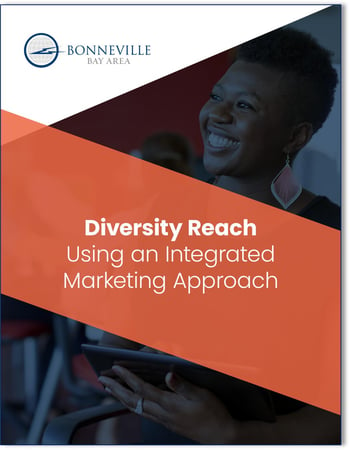

New customers are the lifeblood of most companies. For that reason, it follows that expanding your market share is the best way to ensure your business’s growth and longevity.
Of course, there are several methods of growing market share. In this guide, we’ll focus on one key concept that is often overlooked when executives determine how best to execute their advertising strategy: diversity reach.
Diversity reach is a highly effective tactic when penetrating territories and market sectors that have distinct idiosyncrasies. While this technique won’t require you to change your core message, it will enable you to “tweak” your messaging for optimal effect across the consumer base. Ultimately, you’ll be able to engage with a range of new customers, generate leads and conversions, and drive growth for your brand.
This guide will answer four critical questions around diversity reach:

The Bay Area is a highly diverse region, with many consumer demographics in terms of ethnicity, culture, background, and other indicators.
For example, within the Bay Area, approximately 24% of the population is Hispanic, 23% is Asian, and 6% is African American, with most of the remainder being Caucasian.
With such vast diversity in mind, we must give attention to the concept of reach. Reach, in a marketing context, has been defined as: “the potential number of customers it is possible to reach through an advertising medium (like Television, Radio or Newspaper) or a promotional message or advertising campaign. Reach refers to the number of people who are exposed [to]... an advertising or promotional message.” While reach doesn’t necessarily measure how many consumers saw or heard a marketing message, it indicates how many consumers had the potential to view or listen to the message.
Diversity reach, then, expands upon this concept to encompass audiences from niche cultural groups. In other words, diversity reach considers the need to communicate your brand message in a way that speaks directly to a specific cultural group’s shared experiences. Thus, your core marketing message must be adjusted according to each demographic that is targeted.

Today, many marketers fall into the trap of developing ad creative that has deep roots in their own life experiences, culture, or ethnicity. While the marketer’s preferences and sensibilities may be useful in attracting and engaging with consumers from a similar background, “cookie-cutter” ad creative will likely hold far less appeal for targeted niche demographics.
For a business to truly expand its market share sustainably, it must adjust its brand voice, tone, and messaging to resonate with consumers from highly diverse backgrounds and bring their own set of values, verbiage, preferences, and sensibilities. In short, companies must take diversity reach into account when developing their marketing plan.
Creating target segments (often through highly researched buyer personas) will enable you to implement diversity practically. When your projected market is divided according to subgroups with shared features and characteristics, it becomes much easier to plan for marketing campaigns that incorporate diversity reach.
The bottom line is: You must advertise differently for different audiences. The Bay Area provides a wonderful example of why this approach is so vital. As mentioned in the previous section, the Hispanic and Asian demographics make up almost a quarter of the Bay Area population, respectively. That’s not to mention the significant African American demographic and the “Other Race” category (which makes up a larger percentage of the San Francisco population than the African American community, per data from the 2010 census)

In this regard, it’s important to note that income level is not necessarily a factor that strongly correlates with ethnicity. For example, three of the biggest radio stations in the Bay Area (KBLX, KMVQ, and KOIT) each have a strong reach index with different audience segments. However, their reach statistics look very similar when it comes to annual Household Income (HHI):
| KBLX | KMVQ | KOIT |
| 90,253 listeners HHI: $100,000-$249,999 | 150,478 listeners HHI: $100,000-$249,999 | 207,828 listeners HHI: $100,000-$249,999 |
Other factors, such as the level of education obtained and whether the consumer owns his/her own home, are also comparable across the board. A study from Claritas found that aggregate Hispanic household spending is projected to reach $978 billion in 2020, making Hispanics the single largest and highest-spending minority group in the United States. On the income side, the U.S. Hispanic market’s aggregate annual household income now tops $1.28 trillion.
What’s the point? If you only segment your demographics according to HHI, then you may be shooting yourself in the foot when it comes to diversity reach. Instead, it would almost certainly be more useful to tailor your message according to each specific group’s features without completely discounting other factors such as HHI, education, and location, for example.

There are many misconceptions when it comes to advertising across a diverse consumer base. In the Bay
Area, some common myths include the following notions:
|
"The Bay Area is majority white, ALL areas can be advertised to as if they are white."
|
"If African American and white populations have the same income, you can advertise to them the same."
|
"You can advertise to other cultural groups by looking at your own lived experience."
|
|
The reality is, the white demographic may make up the largest audience segment. Still, the Bay Area does not have a white majority compared to all the other niche demographics. |
The falsity of this concept is borne out by how well KBLX indexes with AA listeners compared to KMVQ and KOIT. KMVQ indexes at 8.3% of black listeners and KOIT at 9.6%. KBLX indexes 83.2% in contrast. In contrast, both KMQV and KOIT over-index with the Asian demographic and index the market average with Hispanic listeners. Tailored messaging plays a huge role in these differences. |
This is erroneous thinking. While many life experiences transcend racial, cultural, or socioeconomic boundaries, others are unique to specific cultures, ethnicities, and upbringings. Messaging aimed at niche groups must tap into these unique experiences for the best results. |

Diversity reach will never achieve maximum impact if restricted by a silo mentality within your organization. Instead, diversity reach is most successful when there is a combined effort involving every department at your company. For instance, one team may capture relevant data on an audience segment, while another team can audit your ad creative with cultural preferences and sensitivities in mind.
Moreover, you should never underestimate the resources that select media partners have at their disposal. These media partners have access to data and channels where diverse groups can be reached. Their expertise can provide a powerful boost to your efforts at deploying diversity reach tactics.
Combing Radio, digital, and influencer marketing into one integrated marketing initiative will help you expand and enhance your diversity reach.


It’s clear to see that diversity reach should be a key consideration in your marketing strategy. Diversity reach takes the concept of “reach” and expands it to account for highly diverse audience segments. It’s important because one message may not have the same appeal across all demographics. Moreover, when you incorporate diversity reach into an integrated marketing strategy — one that combines radio, digital, and influencer marketing — you’ll see an exceptional ROI from your efforts. Of course, implementing diversity reach is easier said than done. For that reason, consider working with an experienced media partner with the knowledge and skills to help integrate your marketing channels and optimize your advertising strategy for all members of your target audience, no matter how diverse their cultures or backgrounds.


Bonneville Bay Area offers integrated marketing solutions that connect businesses with the right local audience enabling brand awareness, activation in the local community, and overall business growth.